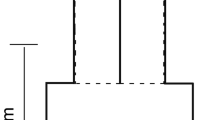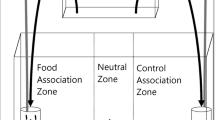Abstract
Alternative sensory modalities (e.g. vision, chemoreception) differ in the spatial scale, permanence and reliability of cues they provide to mate-searching males. Males of terrestrial snake species use chemoreception to locate females over large distances, but phylogenetic shifts to aquatic life render such cues unavailable. Do male sea snakes use alternative modalities for identifying potential sexual partners and if so, are the novel systems as effective for mate-finding as the ancestral ones? Observations and experiments show that free-ranging male turtle-headed sea snakes (Emydocephalus annulatus) in shallow-water reef habitats in New Caledonia use visual cues (including size, movement and color pattern) to assess whether snake-shaped objects are potential sexual partners. Skin lipids (pheromones) are important only after the male comes into physical contact with the stimulus. Visual cues provide unreliable information about potential mates, and function over short distances only (generally, <1 m). In consequence, mate-searching male snakes frequently failed to find nearby females, rarely managed to maintain contact with females they did find, and wasted time and energy investigating inappropriate stimuli (e.g. fishes, sea cucumbers, divers). The loss of effective pheromonal mate-location systems means that mate recognition by aquatic snakes functions over smaller distances than in their terrestrial relatives. Phylogenetic transitions among habitat types thus may directly modify central features of the mating system.




Similar content being viewed by others
References
Andersson M (1994) Sexual selection. Princeton University Press, Princeton, N.J.
Arnold SJ, Duvall D (1994) Animal mating systems: a synthesis based on selection theory. Am Nat 143:317–348
Cabin RJ, Mitchell RJ (2000) To Bonferroni or not to Bonferroni: when and how are the questions. Bull Ecol Soc Am 81:246–248
Chiaraviglio M, Briguera V (2001) Participation of chemical cues in conspecific detection and discrimination in Boa constrictor (Serpentes: Boidae). Gayana Zool 65:5–10
Cooper WEJ, Greenberg N (1992) Reptile coloration and behavior. In: Gans C, Crews D (eds) Biology of the reptilia, vol 18. Hormones, brains and behavior. University of Chicago Press, Chicago, pp 298–422
Duellman WE, Trueb L (1986) Biology of amphibians. McGraw-Hill, New York
Duvall D, Chiszar D (1990) Behavior and chemical ecology of vernal migration and pre- and post-strike predatory activity in prairie rattlesnakes. In: MacDonald DW, Muller-Schwarze D, Natynczuk SE (eds) Chemical signals in vertebrates, vol. 5. Oxford University Press, Oxford, pp 539–554
Duvall D, Schuett GW (1997) Straight-line movement and competitive mate-searching in prairie rattlesnakes, Crotalus viridis viridis. Anim Behav 54:329–334
Duvall D, King MB, Gutzweiler KJ (1985) Behavioral ecology and ethology of the prairie rattlesnake. Nat Geogr Res 1:80–111
Duvall D, Schuett G, Arnold SJ (1992) Pitviper mating systems: ecological potential, sexual selection and microevolution. In: Campbell JA, Brodie EDJ (eds) Biology of the pitvipers. Selva, Tyler, Tex., pp 321–336
Duvall D, Schuett GW, Arnold SJ (1993) Ecology and evolution of snake mating systems. In: Seigel RA, Collins JT (eds) Snakes: ecology and behavior. McGraw-Hill, New York, pp 165–200
Emlen ST, Oring LW (1977) Ecology, sexual selection, and the evolution of mating systems. Science 197:215–223
Endler JA (1983) Natural and sexual selection on color patterns in poeciliid fishes. Environ Biol Fishes 9:173–190
Ford NB (1982) Species specificity of sex pheromone trails of sympatric and allopatric garter snakes (Thamnophis). Copeia 1982:10–13
Ford NB, Low JR (1984) Sex pheromone source location by garter snakes: a mechanism for detection of direction in nonvolatile trails. J Chem Ecol 10:1193–1199
Ford NB, Schofield CW (1984) Species specificity of sex pheromone trails in the plains garter snake, Thamnophis radix. Herpetologica 40:51–55
Gans C (1974) Biomechanics: an approach to vertebrate biology. Lippincott, Philadelphia
Gans C, Mendelssohn H (1972) Sidewinding and jumping progression of vipers. In: Vries A de, Kochva E (eds) Proceedings of the second international symposium on toxins of animal and plant origin. Gordon and Breach, London, pp 17–38
Gillingham JC (1987) Social behavior. In: Seigel RA, Collins JT, Novak SS (eds) Snakes: ecology and evolutionary biology. McGraw-Hill, New York, pp 184–209
Greer AE (1997) The biology and evolution of Australian snakes. Surrey Beatty, Sydney
Guinea ML (1986) Aspects of the biology of the common Fijian sea snake Laticauda colubrina (Schneider). MSc thesis, University of the South Pacific, Fiji
Guinea ML (1996) Functions of the cephalic scales of the sea snake Emydocephalus annulatus. J Herpetol 30:126–128
Haddad CFB, Giaretta AA (1999) Visual and acoustic communication in the Brazilian torrent frog, Hylodes asper (Anura : Leptodactylidae). Herpetologica 55:324–333
Heatwole HF (1999) Sea snakes. University of New South Wales Press, Sydney
Heatwole HF, Minton SAJ, Taylor R, Taylor V (1978) Underwater observations of sea snake behaviour. Rec Aust Mus 31:737–761
Higgie M, Chenoweth S, Blows M (2000) Natural selection and the reinforcement of mate recognition. Science 290:519–521
Ineich I, Laboute P (2002) Sea snakes of New Caledonia. IRD, Paris
LeMaster MP, Mason RT (2002) Variation in a female sexual attractiveness pheromone controls male mate choice in garter snakes. J Chem Ecol 28:1269–1285
LeMaster MP, Moore IT, Mason RT (2001) Conspecific trailing behavior of red-sided garter snakes, Thamnophis sirtalis parietalis, in the natural environment. Anim Behav 61:827–833
Mason RT (1992) Reptilian pheromones. In: Gans C, Crews D (eds) Biology of the Reptilia, vol. 18. Hormones, brains and behavior. University of Chicago Press, Chicago, pp 114–228
Mason RT (1993) Chemical ecology of the red-sided garter snake, Thamnophis sirtalis parietalis. Brain Behav Evol 41:261–268
Mason RT, Fales HM, Jones TH, Pannell LK, Chinn JW, Crews D (1989) Sex pheromones in snakes. Science 245:290–293
Minton SAJ, Dunson WW (1985) Sea snakes collected at Chesterfield Reefs, Coral Sea. Atoll Res Bull 292:101–108
Noble GK (1937) The sense organs involved in the courtship of Storeria, Thamnophis, and other snakes. Bull Am Mus Nat Hist 73:673–725
Panhuis TM, Butlin RK, Zuk M, Tregenza T (2001) Sexual selection and speciation. Trends Ecol Evol 16:364–371
Rasmussen AR (2002) Phylogenetic analysis of the “true” aquatic elapid snakes Hydrophiinae (sensu Smith et al., 1977) indicates two independent radiations into water. Steenstrupia 27:47–63
Ryan MJ, Tuttle MD, Rand AS (1982) Bat predation and sexual advertisement in a neotropical anuran. Am Nat 119:136–139
Shetty S, Shine R (2002) The mating system of yellow-lipped sea kraits (Laticauda colubrina, Laticaudidae). Herpetologica 58:170–180
Shine R (1988) Constraints on reproductive investment: a comparison between aquatic and terrestrial snakes. Evolution 42:17–27
Shine R, Mason RT (2001) Courting male garter snakes use multiple cues to identify potential mates. Behav Ecol Sociobiol 49:465–473
Shine R, O’Connor D, LeMaster MP, Mason RT (2001) Pick on someone your own size: ontogenetic shifts in mate choice by male garter snakes result in size-assortative mating. Anim Behav 61:1133–1141
Shine R, Cogger HG, Reed RN, Shetty SS, Bonnet X (2002a) Aquatic and terrestrial locomotor speeds of amphibious sea-snakes (Serpentes, Laticaudidae). J Zool (Lond) 259:261–268
Shine R, Reed RN, Shetty S, LeMaster M, Mason RT (2002b) Reproductive isolating mechanisms between two sympatric sibling species of sea-snakes. Evolution 56:1655–1662
Shine R, Shine T, Shine BG (2003) Intraspecific habitat partitioning by the sea snake Emydocephalus annulatus (Serpentes, Hydrophiidae): the effects of sex, body size, and color pattern. Biol J Linn Soc 80:1–10
Slip DJ, Shine R (1988) The reproductive biology and mating system of diamond pythons, Morelia spilota (Serpentes, Boidae). Herpetologica 44:396–404
Sutherland WJ (1987) Random and deterministic components of variance in mating success. In: Bradbury JW, Andersson MB (eds) Sexual selection: testing the alternatives. Wiley, New York, pp 209–219
Vitt LJ (1986) Reproductive tactics of sympatric gekkonid lizards with a comment on the evolutionary and ecological consequences of invariant clutch size. Copeia 1986:773–786
Voris HK (1966) Fish eggs as the apparent sole food item for a genus of sea snake, Emydocephalus (Krefft). Ecology 47:152–154
Voris HK (1977) A phylogeny of the sea snakes (Hydrophiidae). Fieldiana Zool 70:79–166
Voris HK, Voris HH (1983) Feeding strategies in marine snakes: an analysis of evolutionary, morphological, behavioral and ecological relationships. Am Zool 23:411–425
Voris HK, Voris HH (1995) Commuting on the tropical tides: the life of the yellow-lipped sea krait. Ocean Realm April 1995:57–61
Weldon PJ, Ortiz R, Sharp TR (1992) The chemical ecology of crotaline snakes. In: Campbell JA, Brodie EDJ (eds) Biology of the pitvipers. Selva, Tyler, Tex., pp 309–319
Acknowledgements
I thank James and Ben Shine, Melanie Elphick, Elizabeth Barrott, Carla Avolio, Amanda Lane, Hal Cogger, Xavier Bonnet and especially Terri Shine for field assistance, and IRD Noumea (especially, Pierre Laboute and Michel Kulbicki) for logistical support. Funding was provided by the Australian Research Council. The study was conducted with approval from New Caledonian wildlife and fisheries authorities, and conformed to all requirements for animal experimentation in that country.
Author information
Authors and Affiliations
Corresponding author
Additional information
Communicated by P. Weatherhead
Rights and permissions
About this article
Cite this article
Shine, R. All at sea: aquatic life modifies mate-recognition modalities in sea snakes (Emydocephalus annulatus, Hydrophiidae). Behav Ecol Sociobiol 57, 591–598 (2005). https://doi.org/10.1007/s00265-004-0897-z
Received:
Revised:
Accepted:
Published:
Issue Date:
DOI: https://doi.org/10.1007/s00265-004-0897-z




